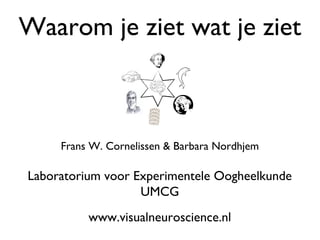
Illusions - in Dutch
- 1. Waarom je ziet wat je ziet Frans W. Cornelissen & Barbara Nordhjem Laboratorium voor Experimentele Oogheelkunde UMCG www.visualneuroscience.nl
- 2. Google: visueel vergelijkbare beelden?
- 3. Niet slecht
- 5. Google vindt dit vergelijkbaar
- 6. Google had ook deze beelden kunnen tonen Maar deed dat niet Waarnemen en herkennen is geen triviaal probleem!
- 7. Waarom zien we wat we zien?
- 10. 11
- 11. Kijk naar de rode stip QuickTime™ and a GIF decompressor are needed to see this picture.
- 12. Kijk naar je buurvrouw of -man
- 13. QuickTime™ and a GIF decompressor are needed to see this picture.
- 14. QuickTime™ and a JVT/AVC Coding decompressor are needed to see this picture.
- 17. Patiënten met schizofrenie minder invloed van context, daardoor BETER in matching taken Anderson et al. 2012
- 18. Mogelijk samenhang met kleinere receptieve velden in de primaire visuele cortex Anderson et al. 2012
- 25. Face adaptation
- 26. QuickTime™ and a Photo - JPEG decompressor are needed to see this picture.
- 27. QuickTime™ and a Photo - JPEG decompressor are needed to see this picture.
- 28. QuickTime™ and a H.264 decompressor are needed to see this picture.
- 30. Waarom je ziet wat je ziet Je brein vergelijkt visuele informatie over de tijd en ruimte, past zich heel snel aan, en laat weg wat er altijd is www.visualneuroscience.nl
- 31. Zien is vergelijken Workshop: Hand illusie
- 33. Zien is leren en interpreteren
- 34. QuickTime™ and a QuickTime™ and a Photo - JPEG decompressor Photo - JPEG decompressor are needed to see this picture. are needed to see this picture.
- 36. Zelfde gezicht Hoog Contrast Laag Contrast Vrouw Man
- 37. 38
- 39. 40
- 40. 41
- 42. Zien is leren en interpreteren Hollow Face Ilusion Workshop: maak je eigen illusie
- 43. Waarom je ziet wat je ziet Je brein vergelijkt visuele informatie over de tijd en ruimte, past zich heel snel aan, en laat weg wat er altijd is Je (brein) ziet niet noodzakelijk wat er echt is, maar wat je hebt leren zien www.visualneuroscience.nl
- 45. 46
- 46. Lothar Spillmann, Joe Hardy, Peter Delahunt, Baingio Pinna, and John S. Werner Tube illusion UCD Medical Center, USA;University of Freiburg, Germany;PositScience, USA;University of Sassari, Italy Take a cardboard tube, such as from a kitchen paper role, and hold it close to your eye, while keeping the other eye open. Look at a bright wall. The disk-shaped area seen through the tube will appear strikingly brighter than the same surface area viewed by the other eye. The effect is reminiscent of a flashlight illuminating the area under consideration. The effect takes a few seconds to fully develop. It also works with a textured surface where it enhances not only the brightness and color, but also the detail.
- 50. Courtesy Stevin Dakin, UCL
- 51. Courtesy Stevin Dakin, UCL
- 52. What do we need to perceive a moving person? QuickTime™ and a Animation decompressor are needed to see this picture.
- 57. QuickTime™ and a GIF decompressor are needed to see this picture.
- 58. QuickTime™ and a GIF decompressor are needed to see this picture. “Change blindness”
- 59. Can you see this? 60
- 63. Neon color spreading van Tuijl (1975)
- 64. Watercolor effect Pinna, Brelstaff & Spillmann (2001)
Notas do Editor
- Not to claim that the only thing going wrong here is picking the right features!
- Silencing illusion
- Face adaptation phenomenon. Explanation: brain contains populations of face sensitive neurons. Neurons adapt, in a similar way as occurs during colour adaptation. Different faces adapt different face neurons.
- Face adaptation phenomenon. Explanation: brain contains populations of face sensitive neurons. Neurons adapt, in a similar way as occurs during e.g. colour adaptation. Different faces adapt different face neurons.
- In the Illusion of Sex, two faces are perceived as male and female. However, both faces are actually versions of the same androgynous face. One face was created by increasing the contrast of the androgynous face, while the other face was created by decreasing the contrast. The face with more contrast is perceived as female, while the face with less contrast is perceived as male. The Illusion of Sex demonstrates that contrast is an important cue for perceiving the sex of a face, with greater contrast appearing feminine, and lesser contrast appearing masculine. Russell, R. (2009) A sex difference in facial pigmentation and its exaggeration by cosmetics. Perception, (38)1211-1219.
- In the Illusion of Sex, two faces are perceived as male and female. However, both faces are actually versions of the same androgynous face. One face was created by increasing the contrast of the androgynous face, while the other face was created by decreasing the contrast. The face with more contrast is perceived as female, while the face with less contrast is perceived as male. The Illusion of Sex demonstrates that contrast is an important cue for perceiving the sex of a face, with greater contrast appearing feminine, and lesser contrast appearing masculine. Russell, R. (2009) A sex difference in facial pigmentation and its exaggeration by cosmetics. Perception, (38)1211-1219.
- perception at different scales
- referred to as inattentive blindness, we’ll later see that attention is a critical part of perception
